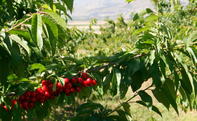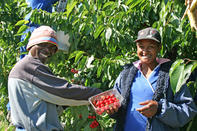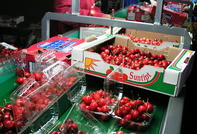Growing sweet cherries, Prunus avium, has some challenges. This not only includes the high cost of establishing an orchard, R250 000 - R300 000/ha in 2018, but also irregular yield and sensitivity to soil conditions and climate.

Cherries are also an alternate bearing crop, producing a high yield one year and a smaller harvest the next. Other alternate bearing crops are olives, oranges, apples and nuts.
Farming Cherries

Cherry trees can only be grown in certain areas in South Africa. They prefer cold winters and don’t like hot summers, wind or frost. In addition, cherry trees are sensitive to root phytophthora and bollworm.
Birds love cherries and can devour up to 10% of the harvest. Growing cherries under netting is a solution to this problem. Too much sunlight during winter can cause sunburn, which increases the occurrence of bacterial canker.
To prevent sunburn afternoon shade or 50% shade netting is advised. Cherries are susceptible to root rot and prefer loose well-drained soil with a pH of 6.
According to soil scientist Nelius Kapp cherries, being deciduous fruit, may require nitrogen, potassium and phosphorus. Also important are boron, zinc and manganese. Soil and foliar analysis will indicate the exact requirements.
In the winter rainfall areas of South Africa, cherries need irrigation for better growth and fruit quality but have lower water requirements, about 50% less per hectare than apples, for example. Drip irrigation with an addiction of nutrients in the irrigation is preferred to micro-irrigation, which may advance the occurrence of stem cankers.
Cherry trees can be bought from nurseries; choose trees grafted on a good rootstock like winter-tolerant Gisela 5 or Malaheb. Increasingly, the Maxima range of rootstocks are being used.
Sweet cherries need cross-pollination, so mix varieties when purchasing. Plant a pollinator variety every second to fifth tree. Sour cherries are self-pollinating. In commercial cherry farming, nine to 12 beehives/ha are used for cherry pollination.
Fruit production starts after three years with full production only attained after six to seven years.
Harvesting Cherries

Cherries are a non-climacteric fruit - this means it is picked fully ripe and does not ripen further after harvesting.
Cherries are a crop with a very short harvest season. The cherry harvest in South Africa starts from week 41 - the second week in October, and ends around week 51 to the end of December, but certain varieties and late harvesting in some areas can extend the season into mid-January.
Cherry-picking is labour intensive as it needs to be hand-picked with the stems intact. An orchard will be picked up to six times in a season. Harvested cherries need to be cooled to 0.5°C as soon as possible; this is often done using a hydro-cooler.
The optimum commercial storage conditions are 0.5°C with a relative humidity of 95%. Due to the extremely perishable nature of cherries, soft flesh, thin skin, fast-ripening, the bulk of South African cherries are air-freighted. If sent by sea, it is essential that pulp temperature not exceed 0℃. The maximum shelf life of cherries is 21 days from picking to the final consumer.
By Marinda Louw